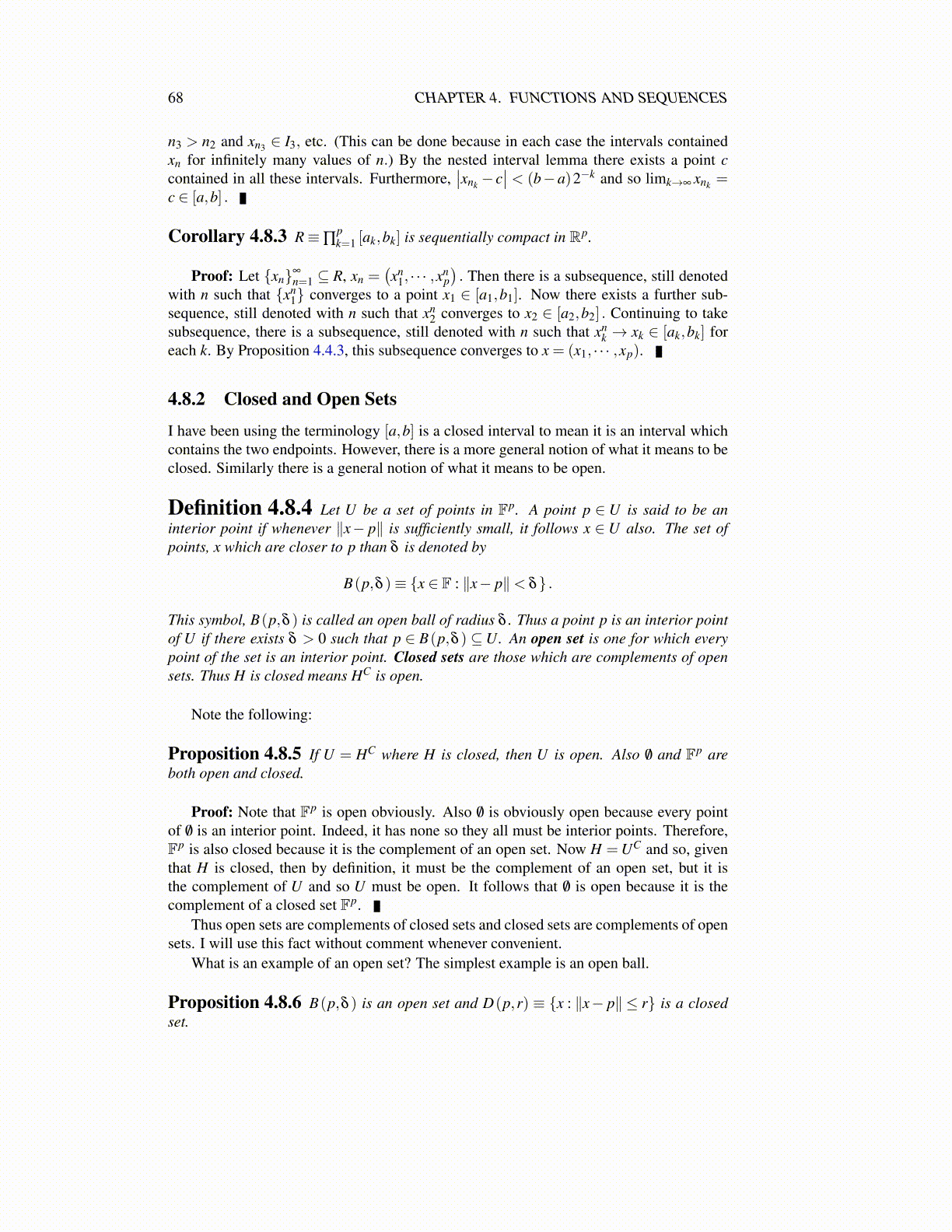
68 CHAPTER 4. FUNCTIONS AND SEQUENCES
Theorem 4.8.11 The following are equivalent.
1. A is closed
2. If {an}∞
n=1 is a sequence of points of A and limn→∞ an = a, then a ∈ A.
3. A contains all of its limit points.
If a is a limit point, then there is a sequence of distinct points of A none of which equala which converges to a.
Proof: 1.⇐⇒2. Say A is closed and an → a where each an ∈ A. If a /∈ A, then thereexists ε > 0 such that B(a,ε)∩A = /0. But then an fails to converge to a so a ∈ A after all.Conversely, if 2. holds and x /∈ A, B
(x, 1
n
)must fail to contain any points of A for some
n ∈ N because if not, you could pick an ∈ B(x, 1
n
)∩A and obtain limn→∞ an = x which
would give x ∈ A by 2. Thus AC is open and A is closed.2.⇒ 3. Say a is a limit point of A. Then by Proposition 4.8.8 there is a sequence of
distinct points of A {an} with an→ a. By 2., a ∈ A.3.⇒ 1. Given 3., why is AC open? Let x ∈ AC. By 3. x cannot be a limit point. Hence
there exists B(x,r) which contains at most finitely many points of A. Since x ∈ AC, noneof these are equal to x. Hence, making r still smaller, one can avoid all of these points.Thus the modified r has the property that B(x,r) contains no points of A and so A is closedbecause its complement is open. The last claim is from Proposition 4.8.8.
Note that part of this theorem says that a set A having all its limit points is the same assaying that whenever a sequence of points of A converges to a point a, then it follows a∈ A.In other words, closed is the same as being closed with respect to containing all limits ofsequences of points of A.
Corollary 4.8.12 Let A be a nonempty set and denote by A′ the set of limit points of A.Then A∪A′ is a closed set and it is the smallest closed set containing A. In fact, A∪A′ =∩{C : C is closed and C ⊇ A} . This set A∪A′ is denoted as A.
Proof: Is it the case that (A∪A′)C is open? This is what needs to be shown if the givenset is closed. Let p /∈ A∪A′. Then since p is neither in A nor a limit point of A, thereexists B(p,r) such that B(p,r)∩A = /0. Therefore, B(p,r)∩A′ = /0 also. This is becauseif z ∈ B(p,r)∩A′, then
B(z,r−∥p− z∥)⊆ B(p,r)
and this smaller ball contains points of A since z is a limit point. This contradiction showsthat B(p,r)∩A′ = /0 as claimed. Hence (A∪A′)C is open because p was an arbitrary pointof (A∪A′)C . Hence A∪A′ is closed as claimed.
It was just shown that A∪A′ ⊇ ∩{C : C ⊇ A}. Now suppose C ⊇ A and C is closed.Then if p is a limit point of A, it follows from Theorem 4.8.11 that there exists a sequenceof distinct points of A converging to p. Since C is closed, and these points of A are all in C,it follows that p ∈C. Hence C ⊇ A∪A′.Thus A∪A′ ⊇ ∩{C : C ⊇ A} ⊇ A∪A′.
Theorem 4.8.13 A set K ̸= /0 inRp is sequentially compact if and only if it is closedand bounded. A set is bounded means it is contained in some ball having finite radius. If Kis sequentially compact and if H is a closed subset of K then H is sequentially compact.